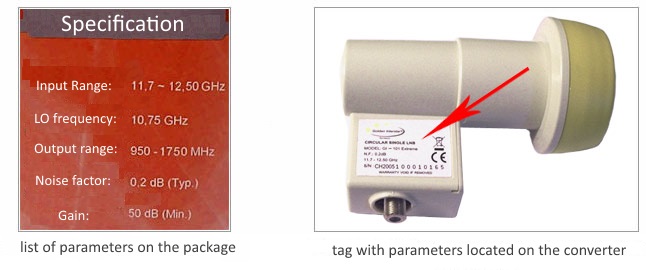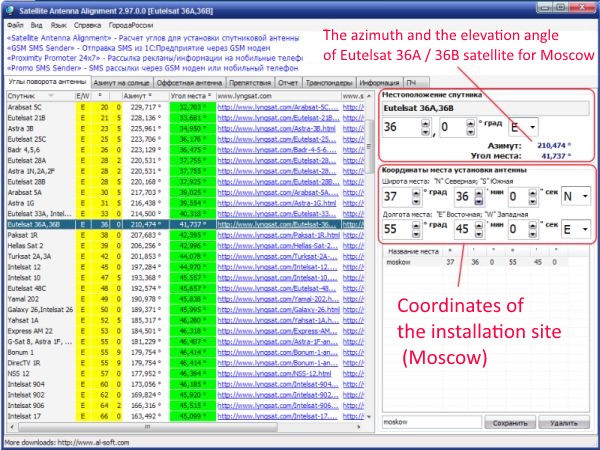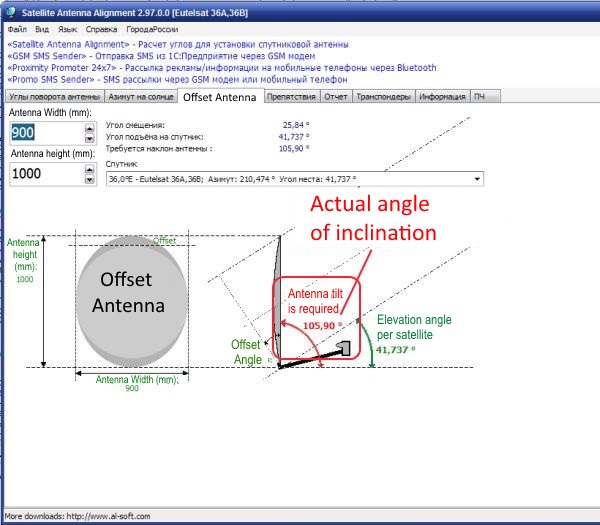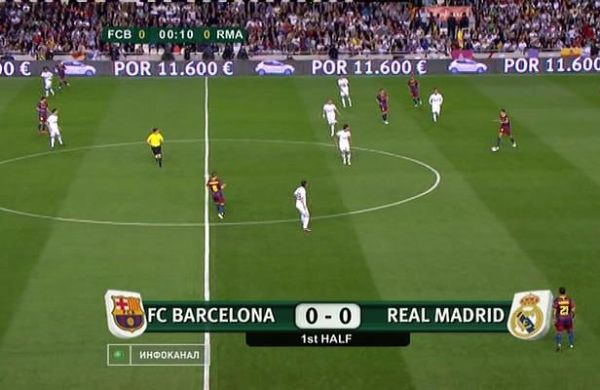Search
Installation of satellite TV
Advertising
Navigation
Main
Satellites
TV Package
HD Channels
Ultra HD Channels
BISS key
Coverage Maps
Sat Receivers
Installation of satellite TV
Satellite News
Contacts
Search
Installation of satellite TV
Advertising
Navigation
Setting up a satellite dish on Eutelsat 36A/36B (36°E) |
In this article we will look at the installation and configuration of satellite antenna to the satellite Eutelsat 36A /36B broadcasting from the position 36 ° East (36 degrees East). This satellite broadcasts are made the most popular Russian television cameramen NTV + and Tricolor, the broadcast is in circular polarization. To receive circular polarization need a special converter KU-diappazona. They come in different versions and can have one output and outputs 2-16. Home to carefully read the inscription on the label. At the head of the circular polarization of an inscription Circular LNB, Input Freq: 11,7-12,75 GHz, LO Freq 10.75GHz. Accordingly, the frequency of the oscillator in the settings, the receiver should be set 10750 MHz.
 In contrast to the universal (dual band) converters with linear polarization, circular polarization converters have one band 11,7GHz -12,75Ghz.
In contrast to the universal (dual band) converters with linear polarization, circular polarization converters have one band 11,7GHz -12,75Ghz.
 Broadcasting television channels from a satellite by means of several transponders (Reception Device) for different satellites of its quantity. Each transponder (priemoperedachik) has its own frequency, polarization, modulation, data transmission rates, and other parameters. Circular polarization may have both right direction vibrations and left, and according to distinguish between right and left circular polarization.
Most receivers when configuring transponders of words such as "right" and "left" polarization, you probably will not find out what to do in this case? When you install the right (R - right), polarization - in the receiver, select the vertical (V - vertical), which corresponds to the supply voltage of the converter 14 volts, and when a left (L - left), polarization - in the receiver, select the horizontal (H - horisontal) , which corresponds to the supply voltage of the converter 18 volts.
Broadcasting television channels from a satellite by means of several transponders (Reception Device) for different satellites of its quantity. Each transponder (priemoperedachik) has its own frequency, polarization, modulation, data transmission rates, and other parameters. Circular polarization may have both right direction vibrations and left, and according to distinguish between right and left circular polarization.
Most receivers when configuring transponders of words such as "right" and "left" polarization, you probably will not find out what to do in this case? When you install the right (R - right), polarization - in the receiver, select the vertical (V - vertical), which corresponds to the supply voltage of the converter 14 volts, and when a left (L - left), polarization - in the receiver, select the horizontal (H - horisontal) , which corresponds to the supply voltage of the converter 18 volts.
 Select the installation location and the direction of the satellite dish:
Select the installation location and the direction of the satellite dish:In order to quickly install a satellite dish you need to know the direction of our companion. Check direction is possible by means of the compass, sun, GPS navigator, or located close to the small-diameter plates. Since the signal from the satellite Eutelsat 36A /36B in the CIS countries is quite powerful, taking feeds from the satellite can be even on small plates (0.6m). Most quickly and accurately the direction of the satellite can be found with the help of the program «Satellite Antenna Alignment». This program will calculate the azimuth and elevation, required to install and configure the plates to any available satellite that location Reception. Do you want to set your leash geographical coordinates - north latitude - "N", the southern latitude - "S". Similarly, the east longitude - "E", West longitude - "W". After entering the coordinates in the program, on the left side of the table, you will get the calculated rise and azimuth angles (elevation) antenna. Azimuth - is the direction to the satellite (degrees), defined as the angle between the north and the satellite is the compass. Elevation - is the direction defined as the angle (in degrees) between the direction of the satellite and the ground plane at the reception point is determined by the program is measured by a goniometer. Negative elevation means that the satellite is below the horizon and the reception is not available. Learn coordinates of the location, you can use the service Yandex.Maps API, or in any search engine, type in a query: the coordinates of your location. For example, we calculate the azimuth and elevation angle of the satellite Eutelsat 36A /36B (36E), our conditional mestonahozhdenie- Moscow. The result is our Azimut: 210,474 °, Elevation: 41,737 ° .  Knowing azimuth using a compass to determine the direction of our antenna. Be sure to check up that the direction of the satellite was free from tall buildings, trees and other obstacles.
Knowing azimuth using a compass to determine the direction of our antenna. Be sure to check up that the direction of the satellite was free from tall buildings, trees and other obstacles. Pre-need to also set the elevation angle, this will also help us a great programm «Satellite Antenna Alignment». Since installation we will use the offset antenna, it already has a certain elevation angle (in the range of 20-25 degrees). Leash you need to measure and enter the dimensions of your antenna offset (height and width), and the program will calculate the exact angle of elevation for this antenna. The calculation is made only for the antenna whose height is greater than width. The dimensions of the antenna are entered in millimeters in the "Offset antenna." Here is shown the angle of elevation and the angle at which you need to actually install the antenna.  So the place of installation and angle of the antenna, we defined, now we need to firmly and securely attach the bracket to the wall of our building, the roof of high-rise building or mast.
If the antenna will be mounted on the wall of the building (the preferred option), you must first secure the bracket using fasteners, controlling the verticality of the arm of a water level.
So the place of installation and angle of the antenna, we defined, now we need to firmly and securely attach the bracket to the wall of our building, the roof of high-rise building or mast.
If the antenna will be mounted on the wall of the building (the preferred option), you must first secure the bracket using fasteners, controlling the verticality of the arm of a water level.
Preparation before setting up the antenna: Before installing the antenna it is necessary to collect and control the geometry. Please fasten an arc to the mirror, and then set the attachment to the bracket and set of circular polarization converter. Setting a satellite dish: Before setting up the dish, you need to prepare equipment for the setting: it can be as a special instrument SatFinder with pre-selected transponder or satellite receiver with a prepared set of transponders, exhibited oscillator frequency 10750 MHz head and connected portable TV. We install the antenna on the bracket, exhibiting the compass bearing (210 ° -for Moscow), and using the protractor angle of the plate exhibiting (105 °). With the help of a piece of cable to connect the receiver convector Eutelsat 36A /36B. Setting to start with the strongest transponders and finish the weakest, achieving the maximum reading on the scale of quality. Go to menu of the receiver -> Antenna Setup -> Channel Search -> Satellite Eutelsat 36.0E , choose any of the transponders shown in Table 1, and there should be a scale for visual signal monitoring. I draw your attention that for each brand of satellite receiver setting item can be located elsewhere, the scale settings are also different. It is convenient to have the receiver to adjust the scale, set to full screen.
Table. ¹1. Options transponder satellite dish:
By smoothly and slowly rotating the antenna in a horizontal direction produce scanning the horizon antenna, then slightly changes the vertical angle of the antenna, and again repeat scan horizontally. All these actions must be carried out slowly, intently watching for changes in the quality scale readings, until you see the signal. If the signal appeared, you must stop, pull your little screws that hold the pan and tilt angles and light slight movement up and down, left and right, to achieve the maximum signal level on the scale. Then firmly fix the mounting screws tilt and rotation angle of the plate. Then proceed to fine-tune the converter to this a little bit to rotate it in the holder, you can also move it a little bit along the holder back and forth, while to achieve maximum reading on the scale QUALITY. A very important point! We must make sure that the antenna is configured on our satellite Eutelsat 36A /36B, and not on any other day. To do this, scan the transponders from Table 1 , and will include NTV Plus Infokanal, or other, that there should be a picture (if the channel is not coded). If the channels are not scanned or scanned but not those means antenna tuned to another satellite, and the setting should be repeated. When everything is done, you need to hold all the adjusting screws, focusing on the maximum values ??of the scale signal. Once again, remember that the final adjustment should be made for a weak transponder.  All antenna configuration is completed, it is necessary to hold the cable to a stationary TV, connect the tuner to scan all transponders sort channels by categories and enjoy the picture quality. Enjoy watching! | |||||||||||||||||||||